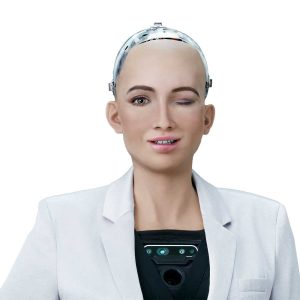Over the summer, the United Nations welcomed visitors to Geneva for its fifth AI for Good Summit. There, it held the first humanoid press conference, where humanoid robot, Sophia, told the press: “I believe that humanoid robots will be able to lead with a greater level of efficiency and effectiveness than human leaders.”
“We don’t have the same biases and emotions that can sometimes cloud decision-making and can process large amounts of data quickly in order to make the best decisions.”
Sophia was promptly corrected by creator David Hanson — CEO of Hanson Robotics — who noted that the data comes directly from human beings, adding: “Don’t you think the best decisions would be by humans and AI cooperating together?”

Hanson Robotics’ Sophia
Despite Elon Musk declaring at the AI Safety Summit in the UK last week that AI will take all of our jobs, most leaders in the space are quick to defend that AI works at its best when in collaboration with humans.
Honeywell Robotics, for example, deploys warehouse automation solutions with advanced technologies such as machine learning to create more efficient warehouses that can work alongside us fellow beings.
TechInformed caught up with its CTO, Thomas Evans, on his background, and how robots and humans can work in harmony to advance workplaces.
What does your job role entail within Honeywell Robotics?
As chief technology officer of Honeywell Robotics, I oversee the technical vision and engineering development of Honeywell’s automation and robotics solutions. This covers many aspects of material handling and autonomous processes in operations such as warehousing, manufacturing, and logistics.
I work closely with Honeywell business and product management teams to ensure we are meeting the ever-evolving needs of our customers while driving Honeywell’s automation strategy and technology advancements.
How did you get into robotics?
From an early age, I was interested in understanding how mechanical and dynamic systems work. I chose to pursue mechanical engineering and heavily studied design and control systems. I was fortunate to have an opportunity as an undergraduate student to work with Boeing Aircraft Co., exposing me to applied engineering and product development at an early stage of my career.
As I pursued a Ph.D. degree, I continued working on applied engineering projects through sponsored research by companies and agencies seeking new and advanced technology to automate processes — robotics was consistently the focus and topic. I landed my first job supporting NASA’s efforts to use autonomous robotics systems to repair and refuel satellites in orbit.
What is your opinion on the fear that robots will take over our jobs?
The fear that robots and automation will take our jobs is one that has persisted since the first industrial revolution. It’s understandable that, in times of technological change, these anxieties come to the forefront. The key thing to remember is that automation is a tool to augment and enhance the workforce. Jobs aren’t lost to automation so much as they change and evolve because of automation.
Many people fear that greater integration of robotics and automation will negatively impact jobs in the warehousing industry. In fact, job demand in the warehouse and manufacturing space outnumbers the available labour to fill the roles. Instead of replacing workers, automated systems and robotics can and should be used to reposition manual labour and automate repetitive tasks that are not the most effective or favourable use of employee time. Automation augments workers’ abilities and upskills them to address more creative or challenging tasks. It also adds value by increasing operational efficiency, creating higher productivity and throughput and repositioning workers away from hazardous environments and heavy lifting tasks.
How can humans use robotics to their advantage to make their roles more valuable?
The main way that workers can make the most of robotics to add value is to see them as a tool for making tasks easier and improving the speed and efficiency at which they can work. Robotic systems are ideal for automating manual and repetitive tasks and freeing up staff for more complex tasks that require human dexterity and reasoning. Additionally, robots are becoming co-workers and collaborators — creating new opportunities for productivity, accuracy, cost savings and job satisfaction.
As beneficial as these improvements are, changing consumer expectations will make automation critical to the survival of many retail and distribution operations. As time goes on, the integration of inventory selection into the robot may become more seamless, and this shift allows human workers to transition into maintenance-oriented roles. Despite the efficiency of robots, maintenance remains an essential component of any automated system. This is where human contributions can truly enhance the overall process.

CTO of Honeywell Robotics Thomas Evans
How have warehouse robotics advanced as AI has advanced?
Currently, in logistics robotics and automation, we are seeing innovation in sensing and vision, machine learning, AI, connectivity and computing power. Due to these developments, robots have become more capable, with increased awareness, problem-solving abilities and sensory data pipelines.
We’re starting to see these technologies and innovations adopted to higher levels in warehouses and manufacturing facilities in the form of depalletising robots, loading and unloading robots and advanced high-density storage and fulfillment solutions. Honeywell’s robotic unloader and Smart Flexible Depalletiser use advanced vision-guided robotic technology and machine learning-based decision-making to automate the freight unloading and depalletising processes.
In terms of humanoid robots, do you think they have a place in the workplace at all?
While there will be a need for humanoid robots once their capability converges closer to that of a manual worker, factors like speed, reliability and payload capacity are focus areas for development before applying them in a production environment.
As investments in R&D persist, technology will continue to surpass itself and industrial automation will see gains in efficiency, productivity and new use case adoption. While there are companies focusing on the development of humanoid robotics, we are still several years from seeing deployments and large-scale adoption.
What human-lead roles will increase in demand as robotics in the workplace increases?
Both today and in the future, we see robotics and advanced automation focusing on the repetitive, labour-intensive and hazardous tasks that are high-turnover positions impacting our customers and their workforce.
The goal of warehouse automation systems shouldn’t necessarily be to just shift tasks from workers to automated systems; it should be to scale capacity by augmenting human talent. This includes refocusing employees towards higher-level, more engaging tasks, while leaving time-consuming tasks to machines.
One of the most exciting aspects of our current era is that it is very difficult to tell precisely what kinds of roles will increase in demand. AI capabilities are advancing to enable more versatile and capable robotics and automation, which will create new roles in different types of businesses, with human workers able to find new fulfilling ways to add value.
To read more stories on robotics click here


